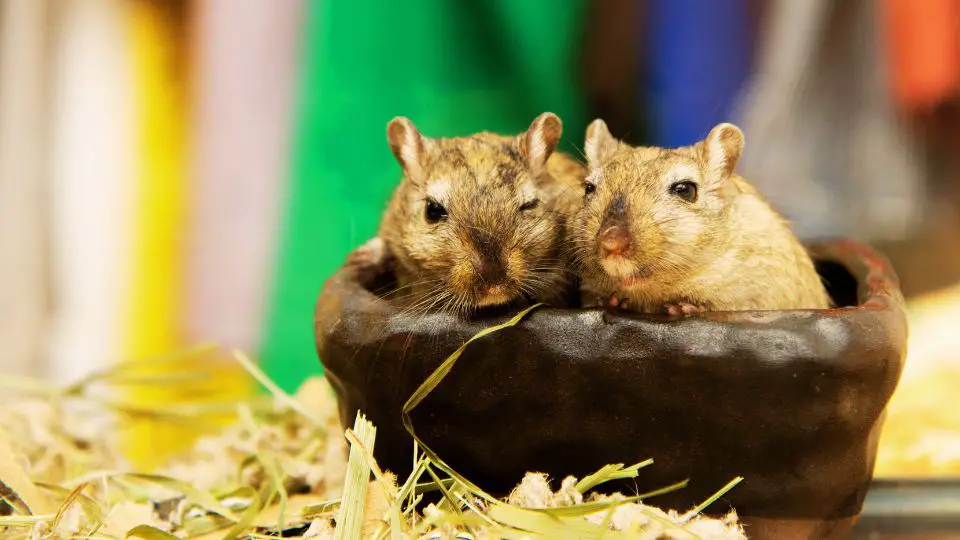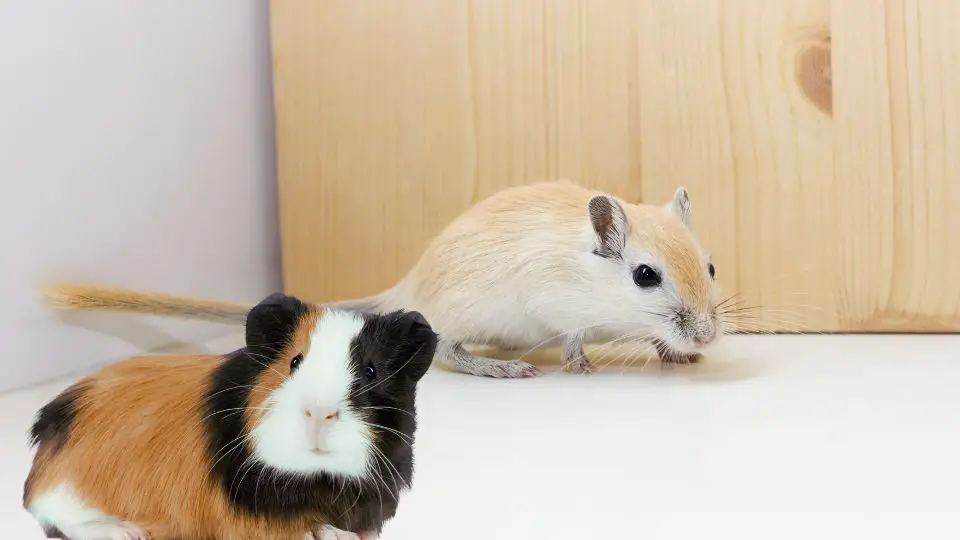Are you considering adding gerbils to your family? One important question to consider is how many gerbils can comfortably live together in one cage.
Gerbils are social animals that thrive on companionship, and providing them with suitable living arrangements is crucial for their well-being.
In this article, we will explore the factors to consider when determining the appropriate number of gerbils for a single cage. From cage size to gerbil behavior, we will delve into the various considerations that can help you create a harmonious and enriching environment for your furry friends.
Factors to Consider
Socialization and mental well-being
Gerbils are highly social creatures and benefit from companionship. We recommend to have a minimum of two gerbils in a single cage. Keeping gerbils in pairs or small groups allows them to interact, play, groom each other, and communicate, which contributes to their overall mental well-being.
Maximum number of gerbils that a cage can accommodate
The maximum number of gerbils that can comfortably live in one cage depends on the size and available space within the enclosure. Gerbils require adequate room for exercise, exploration, and creating territories.
A larger cage with multiple levels and enough space for each gerbil to establish its own area is ideal. A general guideline is to have at least 10 gallons (approximately 38 liters) of space per gerbil.
Age and compatibility
Consider the age and compatibility of the gerbils when determining the suitable number for a cage. We advise to house gerbils of similar ages together to ensure they have similar energy levels and play behaviors.
Introducing gerbils of different ages or temperaments can lead to conflicts or stress within the group. Careful observation and gradual introductions are necessary when introducing new gerbils to an existing group.
Cage Size and Space Requirements
Minimum cage size required
The minimum cage size needed depends on the number of gerbils you plan to house. As a general guideline, for two gerbils, the cage should have a minimum floor space of 20 inches by 12 inches (50 cm by 30 cm), with a height of at least 12 inches (30 cm). For each additional gerbil, add about 25% to the floor space.
Note that these are minimum recommendations, and providing a larger cage will always be beneficial for the well-being of your gerbils.
Ample space for exploration and exercise
Gerbils are active animals that love to run, burrow, and climb. To meet their physical and mental needs, it’s essential to provide enough space for them to move around and explore.
A spacious cage allows gerbils to engage in natural behaviors, such as tunneling through bedding, climbing on platforms or ramps, and running in wheels. The more space they have, the happier and healthier they will be.
Areas within the cage for feeding, sleeping, and toileting
Gerbils appreciate separate areas within their cage for different activities. Providing designated spaces for feeding, sleeping, and toileting helps them maintain a sense of organization and cleanliness.
Consider using shallow dishes or bowls for food and water, cozy nest boxes or hideouts for sleeping, and a specific area with absorbent bedding for toileting. These separate spaces promote a hygienic living environment and allow gerbils to establish their own territories.
Behavioral Observations
When considering how many gerbils can live in one cage, our recommendation to pay attention to their behavior and group dynamics. Gerbils are social animals that thrive in the company of their own kind.
However, overcrowding can lead to territorial disputes, stress, and other behavioral issues. Here’s what you need to know about observing gerbils’ behavior to determine the suitable number of gerbils in a cage:
Signs of Aggression and Territorial Behavior
Observing gerbils’ interactions can give valuable insights into their group dynamics. Watch for signs of aggression, such as chasing, biting, or excessive fighting.
Some level of dominance behavior is normal, but if it escalates into constant aggression, it may indicate that the cage is too crowded. Territorial behavior, such as scent marking or excessive burrowing around certain areas, can also be a sign that gerbils are feeling crowded.
Stress and Overcrowding
Gerbils are sensitive animals, and overcrowding can lead to stress and behavioral problems. Signs of stress may include excessive grooming, overeating, or decreased activity levels. If you notice these signs in your gerbils, it’s essential to assess the number of gerbils in the cage and consider whether it’s causing overcrowding. Providing a spacious and comfortable environment is crucial for their well-being.
Providing Adequate Resources
To prevent competition and conflicts, provide sufficient resources for all gerbils in the cage. This includes food dishes, water bottles, hiding spots, and toys. Lack of resources can lead to fights over limited access, causing stress and tension within the group. By ensuring each gerbil has enough space and resources, you can create a harmonious living environment.
Breeding Considerations
Breeding gerbils can be an exciting endeavor, but it’s essential to approach it with careful consideration. Before deciding to breed gerbils, we consider understanding the potential consequences and responsibilities that come with it is important.
Here are some important factors to consider when it comes to gerbil breeding:
Housing Male and Female Gerbils Together
Gerbils are highly fertile and can breed at a young age. If you house male and female gerbils together, they are likely to mate and produce offspring.
While this can be a desirable outcome for planned breeding, be prepared for the responsibilities that come with it. If you’re not prepared to care for a potentially large number of gerbil pups or find suitable homes for them, it’s best to keep male and female gerbils separate.
Risks of Overpopulation
Gerbils have a relatively short gestation period of around 25-30 days, and a litter can consist of multiple pups. Without proper planning and control, gerbil populations can quickly grow, leading to overpopulation.
This can result in overcrowded cages, increased competition for resources, and a decline in the overall well-being of the gerbils. Responsible breeding involves carefully managing the number of gerbils to ensure their health and welfare.
Health Issues Associated with Breeding
Breeding gerbils can pose risks to the health of both the parents and the offspring. Female gerbils may experience complications during pregnancy or birthing, such as dystocia (difficult labor) or postpartum issues.
Breeding also puts strain on the female’s body, and repeated breeding without adequate rest periods can lead to health problems. Additionally, there is a risk of genetic disorders or inherited conditions being passed down to the offspring if the breeding pair carries any genetic predispositions.
Responsible Breeding Practices
If you decide to breed gerbils, please do so responsibly. This involves selecting healthy, unrelated gerbils with good temperaments and desirable traits.
Careful planning and consideration should be given to ensure suitable homes for the offspring, either by finding responsible adopters or expanding your own gerbil family in a sustainable manner. Breeding should only be pursued if you have the time, resources, and commitment to properly care for the gerbils and their offspring.
Professional Recommendations
When it comes to determining the number of gerbils that can live together in one cage, please seek guidance from professionals who have extensive knowledge and experience with gerbil care. Veterinarians specializing in exotic pets or seasoned gerbil owners can provide valuable insights and recommendations based on best practices.
Here are some professional recommendations to consider:
Consulting with a Veterinarian
Veterinarians who have experience with small mammals like gerbils can offer expert advice on the appropriate number of gerbils for a specific cage size and configuration. They can assess the gerbils’ health, behavior, and the overall suitability of their living environment.
Veterinary professionals can also provide guidance on gerbil breeding, population management, and potential health risks associated with overcrowding.
Following Guidelines from Gerbil Associations
Gerbil associations or clubs often provide guidelines and recommendations on gerbil care, including appropriate group sizes. These organizations are composed of experienced gerbil enthusiasts who have extensive knowledge of gerbil behavior, social dynamics, and housing requirements.
They may have specific guidelines for different gerbil species or breeds, taking into account their unique characteristics.
Seeking Advice from Experienced Gerbil Owners
Seasoned gerbil owners who have successfully housed and cared for multiple gerbils can offer valuable insights based on their firsthand experiences. They can share practical tips on group dynamics, socialization, and maintaining a harmonious gerbil community.
Connecting with experienced gerbil owners through online forums, social media groups, or local gerbil clubs can provide a wealth of information and support.
Tailoring Recommendations to Individual Gerbils
The recommended number of gerbils per cage can vary depending on factors such as the size and layout of the cage, the gerbils’ age and compatibility, and their unique personalities. Each gerbil has individual needs and preferences, so it’s crucial to consider their specific circumstances when determining the appropriate group size.
Conclusion
In conclusion, determining the number of gerbils that can live together in one cage requires careful consideration of several factors, including cage size, gerbil behavior, and compatibility. While gerbils are social animals that benefit from the companionship of their own kind, overcrowding can lead to territorial disputes and stress.
It is recommended to house gerbils in pairs or small groups to ensure their social needs are met, while also providing them with enough space to explore, exercise, and engage in natural behaviors. Consulting with a veterinarian or experienced gerbil owners can offer valuable insights and recommendations tailored to your specific circumstances.
Remember, creating a comfortable and stimulating living environment for your gerbils is key to promoting their overall health and happiness.







